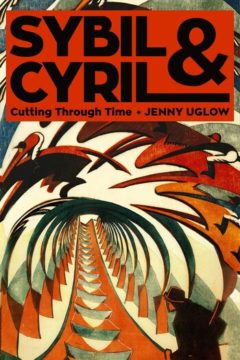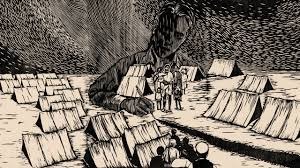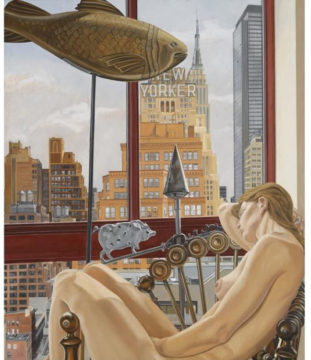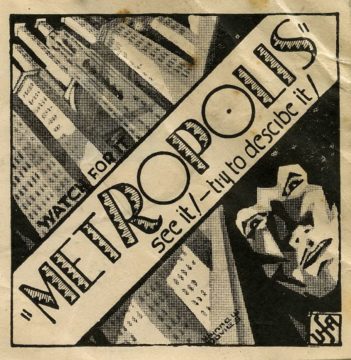Category: Recommended Reading
Sybil Andrews And Cyril Power’s Interwar Art
Apoorva Tadepalli at Bookforum:
 IN A TEACHING MANUAL she wrote in the 1980s, the artist Sybil Andrews stressed the importance of reaching into an image for its essence, stripping away whatever stagnated it. “Can you catch that? Can you get that sense of movement?” she would ask. The advice revealed a design philosophy that had defined her work for decades: her 1931 linocut In Full Cry shows a row of horses leaping over a hedge, their riders’ coattails soaring behind them. The lines themselves are Andrews’s subject, vigorous and unflinching. “I don’t draw the horse jumping,” she said. “I draw the jump.”
IN A TEACHING MANUAL she wrote in the 1980s, the artist Sybil Andrews stressed the importance of reaching into an image for its essence, stripping away whatever stagnated it. “Can you catch that? Can you get that sense of movement?” she would ask. The advice revealed a design philosophy that had defined her work for decades: her 1931 linocut In Full Cry shows a row of horses leaping over a hedge, their riders’ coattails soaring behind them. The lines themselves are Andrews’s subject, vigorous and unflinching. “I don’t draw the horse jumping,” she said. “I draw the jump.”
Jenny Uglow’s new biography, Sybil & Cyril: Cutting Through Time, is a portrait of Andrews and her partner, Cyril Power, and the art world of the interwar years that they were steeped in. Power, an architect by training, met Andrews, twenty-five years his junior, after being discharged at the end of the First World War. He was studying the historic buildings in Bury, England, and noticed her on the street, working on a drawing of a house.
more here.
Sybil and Cyril: Cutting Through Time with Jenny Uglow
On The Tradition Of Mailing Letters
Timothy Jacobson at The New Criterion:
 To write a letter or a postcard meant, relatively speaking, going slow. This was particularly so if one wrote by hand, but true too with a typewriter or word processor and printer. People have always liked to complain about the speed of the mail, but today the once-noble medium has been denigrated to the point of being deemed “snail mail.” Contracts to carry the mail once were prestigious and coveted things and underwrote our evolving national transportation system. The concept of a “post road” dates to colonial times. The Old Boston Post Road, which began as a forest trail in 1673 and eventually became part of US Route 1, is a common reference still in the vernacular of southern New England. Waterways, filling up with mail-carrying canal boats and paddlewheel steamers, were declared post roads in 1823. The Pony Express, though it operated only for eighteen months in 1860 and 1861, quickly entered the mythology of the Old West.
To write a letter or a postcard meant, relatively speaking, going slow. This was particularly so if one wrote by hand, but true too with a typewriter or word processor and printer. People have always liked to complain about the speed of the mail, but today the once-noble medium has been denigrated to the point of being deemed “snail mail.” Contracts to carry the mail once were prestigious and coveted things and underwrote our evolving national transportation system. The concept of a “post road” dates to colonial times. The Old Boston Post Road, which began as a forest trail in 1673 and eventually became part of US Route 1, is a common reference still in the vernacular of southern New England. Waterways, filling up with mail-carrying canal boats and paddlewheel steamers, were declared post roads in 1823. The Pony Express, though it operated only for eighteen months in 1860 and 1861, quickly entered the mythology of the Old West.
more here.
Thursday Poem
Now Sing
NOW sing: the guards howling
beat him with obscentities.
….. But he did.
His legend is
He was singing
…………………. Venceremos
when they shot him.
Even for them, it was too much
They killed him,
they couldn’t kill him enough.
Victor Jara
…………… sin guitarra,
who’d held out with Blood stumps
……………………………………………… and sung.
by James Scully
from Poetry Like Bread
—Poets of the Political Imagination
from Curbstone Press, 1994
Seventy-five Years After Indian Partition, Who Owns the Narrative?
Parul Sehgal in The New Yorker:
 Before it was an edict, and a death sentence, it was a rumor. To many, it must have seemed improbable; I imagine my grandmother, buying her vegetables at the market, settling her baby on her hip, craning to hear the news—a border, where? Two borders, to be exact. On the eve of their departure, in 1947, after more than three hundred years on the subcontinent, the British sliced the land into a Hindu-majority India flanked by a Muslim-majority West Pakistan and East Pakistan (now Bangladesh), a thousand miles apart. The boundaries were drawn up in five weeks by an English barrister who had famously never before been east of Paris; he flew home directly afterward and burned his papers. The slash of his pen is known as Partition.
Before it was an edict, and a death sentence, it was a rumor. To many, it must have seemed improbable; I imagine my grandmother, buying her vegetables at the market, settling her baby on her hip, craning to hear the news—a border, where? Two borders, to be exact. On the eve of their departure, in 1947, after more than three hundred years on the subcontinent, the British sliced the land into a Hindu-majority India flanked by a Muslim-majority West Pakistan and East Pakistan (now Bangladesh), a thousand miles apart. The boundaries were drawn up in five weeks by an English barrister who had famously never before been east of Paris; he flew home directly afterward and burned his papers. The slash of his pen is known as Partition.
A tidy word, “Partition.” Amid what the Punjabis call the raula—the “uproar”—the region convulsed with violence, Hindus and Sikhs on one side, Muslims on the other. Entire villages were massacred. Neighbors turned on each other. It’s estimated that a million people were killed, and that seventy-five thousand women and girls were abducted and raped, a third of them under the age of twelve. Millions of refugees fled in one of the largest and most rapid migrations in history. “Blood trains” crisscrossed the fresh border, carrying silent cargo—passengers slaughtered during the journey. Cities transformed into open-air refugee camps, like the one in Delhi to which my grandmother escaped in the night, alone with her children, feeding the baby opium, the story goes, so he would not cry.
More here.
Wednesday, December 28, 2022
The first Romantics
Andrea Wulf in Aeon:
 In September 1798, one day after their poem collection Lyrical Ballads was published, the poets Samuel Taylor Coleridge and William Wordsworth sailed from Yarmouth, on the Norfolk coast, to Hamburg in the far north of the German states. Coleridge had spent the previous few months preparing for what he called ‘my German expedition’. The realisation of the scheme, he explained to a friend, was of the highest importance to ‘my intellectual utility; and of course to my moral happiness’. He wanted to master the German language and meet the thinkers and writers who lived in Jena, a small university town, southwest of Berlin. On Thomas Poole’s advice, his motto had been: ‘Speak nothing but German. Live with Germans. Read in German. Think in German.’
In September 1798, one day after their poem collection Lyrical Ballads was published, the poets Samuel Taylor Coleridge and William Wordsworth sailed from Yarmouth, on the Norfolk coast, to Hamburg in the far north of the German states. Coleridge had spent the previous few months preparing for what he called ‘my German expedition’. The realisation of the scheme, he explained to a friend, was of the highest importance to ‘my intellectual utility; and of course to my moral happiness’. He wanted to master the German language and meet the thinkers and writers who lived in Jena, a small university town, southwest of Berlin. On Thomas Poole’s advice, his motto had been: ‘Speak nothing but German. Live with Germans. Read in German. Think in German.’
After a few days in Hamburg, Coleridge realised he didn’t have enough money to travel the 300 miles south to Jena and Weimar, and instead he spent almost five months in nearby Ratzeburg, then studied for several months in Göttingen. He soon spoke German. Though he deemed his pronunciation ‘hideous’, his knowledge of the language was so good that he would later translate Friedrich Schiller’s drama Wallenstein (1800) and Goethe’s Faust (1808). Those 10 months in Germany marked a turning point in Coleridge’s life. He had left England as a poet but returned with the mind of a philosopher – and a trunk full of philosophical books.
More here.
Females on average perform better than males on a ‘theory of mind’ test across 57 countries
Research from the University of Cambridge in Medical Xpress:
 Females, on average, are better than males at putting themselves in others’ shoes and imagining what the other person is thinking or feeling, suggests a new study of over 300,000 people in 57 countries.
Females, on average, are better than males at putting themselves in others’ shoes and imagining what the other person is thinking or feeling, suggests a new study of over 300,000 people in 57 countries.
Researchers found that females, on average, score higher than males on the widely used “Reading the Mind in the Eyes” Test, which measures “theory of mind” (also known as “cognitive empathy”). This finding was observed across all ages and most countries.
The study, published in the Proceedings of the National Academy of Sciences, is the largest study of theory of mind to date.
More here.
The Bomb Didn’t Beat Japan … Stalin Did
Ward Wilson in Foreign Policy:
 The U.S. use of nuclear weapons against Japan during World War II has long been a subject of emotional debate. Initially, few questioned President Truman’s decision to drop two atomic bombs, on Hiroshima and Nagasaki. But, in 1965, historian Gar Alperovitz argued that, although the bombs did force an immediate end to the war, Japan’s leaders had wanted to surrender anyway and likely would have done so before the American invasion planned for Nov. 1. Their use was, therefore, unnecessary. Obviously, if the bombings weren’t necessary to win the war, then bombing Hiroshima and Nagasaki was wrong. In the 48 years since, many others have joined the fray: some echoing Alperovitz and denouncing the bombings, others rejoining hotly that the bombings were moral, necessary, and life-saving.
The U.S. use of nuclear weapons against Japan during World War II has long been a subject of emotional debate. Initially, few questioned President Truman’s decision to drop two atomic bombs, on Hiroshima and Nagasaki. But, in 1965, historian Gar Alperovitz argued that, although the bombs did force an immediate end to the war, Japan’s leaders had wanted to surrender anyway and likely would have done so before the American invasion planned for Nov. 1. Their use was, therefore, unnecessary. Obviously, if the bombings weren’t necessary to win the war, then bombing Hiroshima and Nagasaki was wrong. In the 48 years since, many others have joined the fray: some echoing Alperovitz and denouncing the bombings, others rejoining hotly that the bombings were moral, necessary, and life-saving.
Both schools of thought, however, assume that the bombing of Hiroshima and Nagasaki with new, more powerful weapons did coerce Japan into surrendering on Aug. 9. They fail to question the utility of the bombing in the first place — to ask, in essence, did it work?
More here.
Noam Chomsky’s Reflections on Philosophy and Linguistics
From The Archives: Pearlstein Today: Upping The Ante
Robert Storr at Art in America:
 FROM THE OUTSET, Pearlstein has occupied an anomalous position within his generation, for he has been not only the most uncompromising exponent of an unpopular style but its most visible and possibly most successful practitioner. In large measure, Pearlstein owes his special status among fellow Realists and within the art world generally to his gift for ideas and advocacy. It was more by force of argument than by example that he was able in the early 1960s to place a supposedly marginal concern—painting the figure from life—somewhere near the center of critical debate, and to link his cause to that of other artists, many of them abstractionists, who were faced with the task of sorting out the debris left by the first wave of Abstract Expressionism.
FROM THE OUTSET, Pearlstein has occupied an anomalous position within his generation, for he has been not only the most uncompromising exponent of an unpopular style but its most visible and possibly most successful practitioner. In large measure, Pearlstein owes his special status among fellow Realists and within the art world generally to his gift for ideas and advocacy. It was more by force of argument than by example that he was able in the early 1960s to place a supposedly marginal concern—painting the figure from life—somewhere near the center of critical debate, and to link his cause to that of other artists, many of them abstractionists, who were faced with the task of sorting out the debris left by the first wave of Abstract Expressionism.
Pearlstein understood that if realist art was to equal the conviction and power of abstract painting and avoid a permanent ghetto identity, it had somehow to find common ground with the most energetic work of other artists battling against “mainstream” dogma. He found that common ground by redefining the dialectic of modernism as taking place not primarily between representation and abstraction but between a rigorous, nonnarrative formalism and a too easily learned romanticism.
more here.
Unraveling A Christmas Music Mystery
Robert Slifkin at Artforum:
 A FEW YEARS AGO, while flipping through the new arrivals crate at Nice Price Records in Raleigh, North Carolina, where I was visiting family over the holidays, I became transfixed by what I heard playing on the store’s stereo system. It was immediately recognizable as Christmas music: A jubilant, resonant male baritone implored the listener to “let me hang my mistletoe over your head / and let me love you.” But the voice, landing somewhere between the velvet burliness of Teddy Pendergrass and the genteel phrasing of Lou Rawls, like the lustrous production and extravagant, modern R&B arrangement, which included female backup singers who swooned along to the singer’s seductive caroling, seemed unlocatable. Likewise, the song, a lurching minor-key slow jam in 3/4 time, had a weird melancholia at odds with the enforced buoyancy of the holiday season even as it summoned a long tradition of holiday music, such as “Have Yourself a Merry Little Christmas” and “Blue Christmas,” that expresses how cheery expectations at year’s end can often yield an aching emptiness. Amid these mixed messages and sundry stylistic signals, it was hard to tell if the song was festive burlesque or heartfelt holiday paean. I was intrigued, to say the least.
A FEW YEARS AGO, while flipping through the new arrivals crate at Nice Price Records in Raleigh, North Carolina, where I was visiting family over the holidays, I became transfixed by what I heard playing on the store’s stereo system. It was immediately recognizable as Christmas music: A jubilant, resonant male baritone implored the listener to “let me hang my mistletoe over your head / and let me love you.” But the voice, landing somewhere between the velvet burliness of Teddy Pendergrass and the genteel phrasing of Lou Rawls, like the lustrous production and extravagant, modern R&B arrangement, which included female backup singers who swooned along to the singer’s seductive caroling, seemed unlocatable. Likewise, the song, a lurching minor-key slow jam in 3/4 time, had a weird melancholia at odds with the enforced buoyancy of the holiday season even as it summoned a long tradition of holiday music, such as “Have Yourself a Merry Little Christmas” and “Blue Christmas,” that expresses how cheery expectations at year’s end can often yield an aching emptiness. Amid these mixed messages and sundry stylistic signals, it was hard to tell if the song was festive burlesque or heartfelt holiday paean. I was intrigued, to say the least.
I asked the person behind the counter what I was hearing and they pulled out a vinyl copy of Merry Christmas to You from Joseph. The cover art, featuring an apparently Photoshopped portrait of a Black man wearing a Santa outfit and a pair of headphones, didn’t clarify things.
more here.
Merry Christmas To You From Joseph
Festive re-reads: Ethan Frome by Edith Wharton
Rosalind Jana in The Guardian:
 Ethan Frome is not your typical festive book. There are no fabulous parties or thawed hearts, no warming morals about the power of togetherness realised with a fireplace crackling somewhere in the background. In fact, Edith Wharton’s 1911 novella is a melancholy, mean little story, as chilly in tone as the lonely Massachusetts landscape with its “sheet of snow perpetually renewed from … pale skies”. And yet, there’s something in it that makes it a perfect read for those slushy days between Christmas and new year. Perhaps it’s the length: short enough to be consumed in one or two sittings, gulped down like ice water. Perhaps it’s the growing sense of foreboding, ideal for those who prefer their December reading to be of the truly bleak midwinter variety (or anyone in need of a palate cleanser after all that yuletide indulgence).
Ethan Frome is not your typical festive book. There are no fabulous parties or thawed hearts, no warming morals about the power of togetherness realised with a fireplace crackling somewhere in the background. In fact, Edith Wharton’s 1911 novella is a melancholy, mean little story, as chilly in tone as the lonely Massachusetts landscape with its “sheet of snow perpetually renewed from … pale skies”. And yet, there’s something in it that makes it a perfect read for those slushy days between Christmas and new year. Perhaps it’s the length: short enough to be consumed in one or two sittings, gulped down like ice water. Perhaps it’s the growing sense of foreboding, ideal for those who prefer their December reading to be of the truly bleak midwinter variety (or anyone in need of a palate cleanser after all that yuletide indulgence).
More here.
Our Favorite Cancer Stories of 2022
Dan Robitzski in The Scientist:
 Typically, if a cell gets squeezed too hard, it dies. But for a metastasizing cancer cell, the process of squeezing through the narrow channels of the circulatory system may trigger a series of mutations that help the cell stave off programmed cell death while also evading the immune system, according to in vitro and mouse research published in eLife in March. In the experiment, cell nuclei burst open as the cells squeezed their way through a narrow channel, rendering themselves susceptible to various mutations. In general, this suite of changes helped the migrating cancer survive metastasis, which is an otherwise risky journey for a cell to take. However, it’s not yet clear whether this same process occurs in humans, as the mouse model lacked an immune response and the artificial channels in vitro were imperfect models of human blood vessels.
Typically, if a cell gets squeezed too hard, it dies. But for a metastasizing cancer cell, the process of squeezing through the narrow channels of the circulatory system may trigger a series of mutations that help the cell stave off programmed cell death while also evading the immune system, according to in vitro and mouse research published in eLife in March. In the experiment, cell nuclei burst open as the cells squeezed their way through a narrow channel, rendering themselves susceptible to various mutations. In general, this suite of changes helped the migrating cancer survive metastasis, which is an otherwise risky journey for a cell to take. However, it’s not yet clear whether this same process occurs in humans, as the mouse model lacked an immune response and the artificial channels in vitro were imperfect models of human blood vessels.
More here.
Wednesday Poem
Vows
I feel my failure intensely
as if it were a vital organ
the gods grew from the side of my head.
You can’t cover it with a hat and I no longer
can sleep on that side it’s so tender.
I wasn’t quite faithful enough
to carry this sort of weight up the mountain.
When I took my vows at nineteen
I had no idea that gods were so merciless.
Fear makes for good servants
and bravery is fraudulent. When I awoke
I wasn’t awake enough.
by Jim Harrison
from Poetic Outlaws
and here
Tuesday, December 27, 2022
Vladimir Nabokov’s “The Cinema” (1928)
Luke Parker in the Los Angeles Review of Books:
 Nabokov loved film, hopelessly. As a young writer in Weimar exile, this Russian aristocrat and Cambridge graduate rented Berlin apartments amidst the city’s countless movie theaters and neon signs, becoming a regular moviegoer. He was less a connoisseur than an avid consumer. Nabokov’s absorption of this mass of films — mostly forgettable, many lost — made him an authority on cinema in the aggregate. It is to these genre films, these sequels and knockoffs, that Nabokov responds in his poem “The Cinema” (“Kinematograf”), and not to the film art and auteur cinema of retrospective accounts. The setting here is not a grandiose premiere in a movie palace. Instead, we are in a corner theater watching a run-of-the-mill American or German release, another product of the Weimar and Hollywood film factories which together accounted for nearly all the films seen by the young émigré in Berlin. Seated among German salesclerks, Nabokov is both charmed and amused. As by all accounts he was in real life: a contemporary recalled the 20-something Nabokov laughing so hard at American slapstick that, choking and shaking with mirth, he had to leave the screening.
Nabokov loved film, hopelessly. As a young writer in Weimar exile, this Russian aristocrat and Cambridge graduate rented Berlin apartments amidst the city’s countless movie theaters and neon signs, becoming a regular moviegoer. He was less a connoisseur than an avid consumer. Nabokov’s absorption of this mass of films — mostly forgettable, many lost — made him an authority on cinema in the aggregate. It is to these genre films, these sequels and knockoffs, that Nabokov responds in his poem “The Cinema” (“Kinematograf”), and not to the film art and auteur cinema of retrospective accounts. The setting here is not a grandiose premiere in a movie palace. Instead, we are in a corner theater watching a run-of-the-mill American or German release, another product of the Weimar and Hollywood film factories which together accounted for nearly all the films seen by the young émigré in Berlin. Seated among German salesclerks, Nabokov is both charmed and amused. As by all accounts he was in real life: a contemporary recalled the 20-something Nabokov laughing so hard at American slapstick that, choking and shaking with mirth, he had to leave the screening.
“The Cinema,” a piece of light verse which touches upon deeper themes — the relation of inanimate to animate, the place of literature in a media age, the future of Russians among Americanized Europeans — was first published in the Russian Berlin newspaper The Rudder (Rul’) in late 1928.
More here.
Straight talk about epigenetics and intergenerational trauma
Razib Khan in Unsupervised Learning:
 In the last decade, sweeping mainstream-media claims about epigenetics’ expansive role in shaping our world have become hard to escape. I am a geneticist and happy to stipulate that epigenetics is responsible for a considerable amount of our planet’s dazzling biological complexity. And yet when someone comes at me with explanations of anything social and behavioral in humans predicated on epigenetic effects, I cringe like an astronomer informed that planetary dynamics determine my personal character (typical Capricorn hubris they might say). The details of your star chart might be precisely correct, yet I don’t have to tell you that no astronomer seriously ascribes comparable validity to astrology and astronomy. Epigenetics is a powerful and ubiquitous process in biology but entails no mechanism equipped to explain any of the multi-generational psychological phenomena it’s called upon to legitimize in media coverage, claims about which are both reliably overblown and entirely speculative. Let’s inventory epigenetics’ actual reach and influence; you can arrive at your own conclusions about whether it is plausibly, as headlines often claim, the transmission mechanism for such phenomena in humans as “intergenerational trauma.”
In the last decade, sweeping mainstream-media claims about epigenetics’ expansive role in shaping our world have become hard to escape. I am a geneticist and happy to stipulate that epigenetics is responsible for a considerable amount of our planet’s dazzling biological complexity. And yet when someone comes at me with explanations of anything social and behavioral in humans predicated on epigenetic effects, I cringe like an astronomer informed that planetary dynamics determine my personal character (typical Capricorn hubris they might say). The details of your star chart might be precisely correct, yet I don’t have to tell you that no astronomer seriously ascribes comparable validity to astrology and astronomy. Epigenetics is a powerful and ubiquitous process in biology but entails no mechanism equipped to explain any of the multi-generational psychological phenomena it’s called upon to legitimize in media coverage, claims about which are both reliably overblown and entirely speculative. Let’s inventory epigenetics’ actual reach and influence; you can arrive at your own conclusions about whether it is plausibly, as headlines often claim, the transmission mechanism for such phenomena in humans as “intergenerational trauma.”
More here.
Angus Deaton: Who Broke American Democracy?
Angus Deaton in Project Syndicate:
 The current mainstream narrative in the United States holds that democracy is under threat from MAGA zealots, election deniers, and Republicans who are threatening to ignore unfavorable results (as well as recruiting loyalists to oversee elections and police polling places).
The current mainstream narrative in the United States holds that democracy is under threat from MAGA zealots, election deniers, and Republicans who are threatening to ignore unfavorable results (as well as recruiting loyalists to oversee elections and police polling places).
That narrative is true, but only up to a point. There is another, longer-running story with a different set of malefactors. It’s a story in which, for more than 50 years, Americans without college degrees have seen their lives deteriorate over a range of material, health, and social outcomes.
Although two-thirds of the adult US population does not have a four-year college degree, the political system rarely responds to their needs and has frequently enacted policies that harm them in favor of corporate interests and better-educated Americans.
More here.
